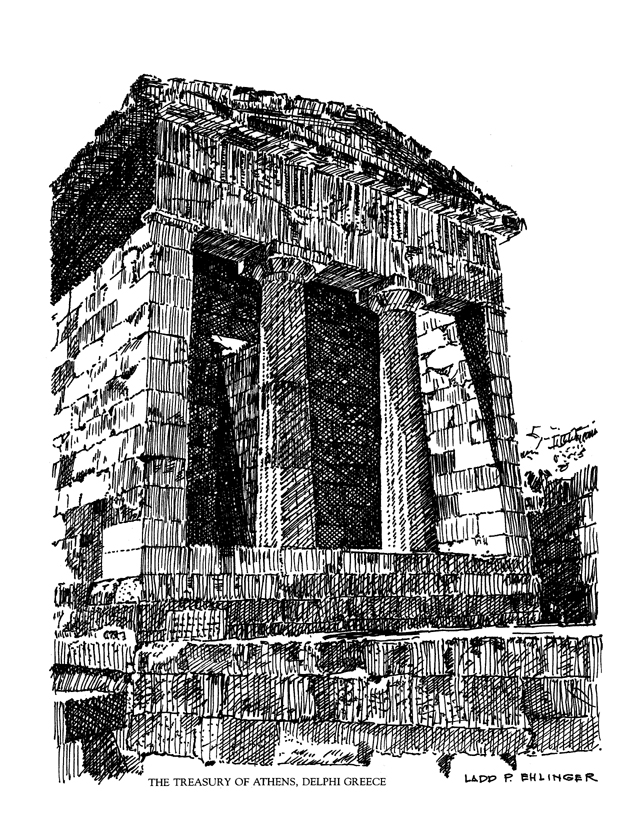
Projects Newsletters Personnel Contact

This month's limited edition signed print by Ladd P. Ehlinger is of the Treasury of Athens at Delphi, Greece. The view in the sketch is of the east facade with the sun shining from the west, looking slightly up the mountain. This type of temple style is architectonically known as a 'distyle in antis' with Doric style columns. This particular style has a pair of columns framed or bracketed between walls. This framing of the columns by the walls gives a strong aesthetic focus to the columns as a picture frame does to a picture, and was a common device used for treasuries.
Delphi was a Greek city founded in prehistoric times upon a legend from Greek mythology. On the precise spot where two eagles. freed by the god Zeus. flew down to earth for the first time, the first shrine at Delphi was founded and consecrated to 'Mother Earth', Gaia. Themis, identified by many as synonymous with Gaia herself, was the sole heiress to the shrine and she, in turn. ceded her place to Apollo, the god who came from the sea and slew the Python near the Phaidriade rocks.
Delphi was thus a shrine or sanctuary. and served as a focus for the pious pilgrims of the Greek city states. These city states made the various shrines about Greece into 'festival cities', where competitions in athletics, drama, oratory and the like were held between the various city states at the time of the feasts of the gods being worshipped at the particular shrine. These feasts varied with the calendar and from city to city. Olympus is probably the most famous city of these competitions, from which our present day Olympics are derived.
Delphi was also known as the 'navel of the earth', and a strange massive crock of pottery was created to represent the concept. It was about 5.5' tall and 4.5' in diameter, oval in shape, with various icons embellishing its surface. This object was venerated during the festivals.
Delphi is in the very mountainous region of Corinth near the sea. The only flat land in the city was used for the athletic fields. There were numerous structures built to service the events. the largest of which is an amphitheatre built into the mountainside. The largest temple was the Temple of Apollo, just up the mountain from the Treasury of Athens.
The Temple of Apollo was where the famous 'Oracle of Delphi' was resident. The oracle was always a female who was kept in a cage in the basement of the temple and fed laurel leaves and other hallucinogenic drugs. She was kept in a stupor at all times. When the faithful would pose questions to her through a screen in the main floor of the temple. the answers were governed by her drug induced stupor. Most oracles did not live very long.
Another one of the ways the various city states competed at the shrines was to build 'thesauroi' or treasuries. The treasuries functioned somewhat as banks, but they were offered to the gods as tokens of gratitude by the city states. They played an important part in the embellishment of Hellenic sanctuaries. They conveyed outward indications of power and ostentatiousness, but they are nevertheless of very high significance in architectural history. Very often they are in a better state of preservation than larger buildings. At Delphi. the Treasury is one of the few remaining buildings.
The treasuries also reveal the ancient Greek philosophy of architecture: buildings were also works of sculpture so that the two arts were often associated in a search for plasticity. These buildings were of restricted proportions, the treasury of the Athenians measures 22.1' by 317' in plan. The concept was that of a 'jewel box'.